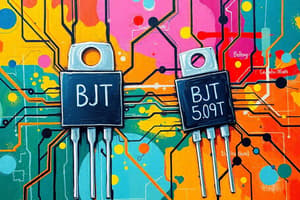Podcast
Questions and Answers
What does BJT stand for?
What does BJT stand for?
- Binary Junction Transistor
- Bipolar Junction Triode
- Binary Joint Terminal
- Bipolar Junction Transistor (correct)
What is the primary application of BJT?
What is the primary application of BJT?
- Amplification of weak signals (correct)
- Rectification of AC power
- Regulation of DC power
- Oscillation of radio frequencies
What is the main advantage of BJT over other types of transistors?
What is the main advantage of BJT over other types of transistors?
- Lower power consumption
- Faster switching times
- Higher current handling capacity (correct)
- Greater voltage amplification
What is the typical configuration of a BJT?
What is the typical configuration of a BJT?
What is the main limitation of BJT?
What is the main limitation of BJT?
Flashcards are hidden until you start studying
Study Notes
BJT Basics
- BJT stands for Bipolar Junction Transistor
Primary Application
- The primary application of BJT is to amplify or switch electronic signals
Advantage over Other Transistors
- The main advantage of BJT over other types of transistors is its high current density, allowing it to handle high current and power applications
Typical Configuration
- The typical configuration of a BJT is in a Common Emitter (CE) or Common Collector (CC) setup, which enables it to function as an amplifier or a switch
Main Limitation
- The main limitation of BJT is its low input impedance, which can lead to signal loading and distortion, and requires careful impedance matching
Studying That Suits You
Use AI to generate personalized quizzes and flashcards to suit your learning preferences.




